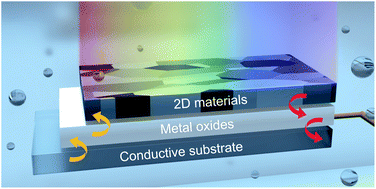Nanoscale metal oxides–2D materials heterostructures for photoelectrochemical water splitting—a review
Abstract
Photoelectrochemical (PEC) water splitting is an interesting approach to harness clean and renewable solar energy to generate green hydrogen. To this end, metal oxides (MOs) have been investigated as photoelectrodes (photoanode and photocathode) due to their tunable optoelectronic properties and abundance, but achieving an efficient overall performance based on single MOs is very challenging due to their narrow visible light absorption, unfavorable band position, low charge mobilities, and limited stability. Heterostructuring MOs with other materials has therefore been proposed in the literature. In this review, we specifically highlight photoelectrodes based on the heterostructure of MOs and an emerging group of 2D materials consisting of mono elemental (Xenes), carbides/nitrides/carbonitrides (MXenes), boron carbon nitride (BCNs), transition metal dichalcogenides (TMDs), metal–organic frameworks (MOFs), and bismuth oxyhalides (BiOX). The benefits of the formation of MOs/2D materials heterostructures are outlined, and the state-of-the-art of MOs/2D materials heterostructures as photoelectrodes with various architectures are extensively discussed. Finally, a critical outlook on fundamental challenges and potential future directions in the development of MOs/2D materials heterostructures is presented.

- This article is part of the themed collection: 2022 Journal of Materials Chemistry A Most Popular Articles


 Please wait while we load your content...
Please wait while we load your content...